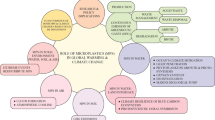Abstract
The experimental results of evaluating levels of air pollution with persistent organic pollutants (POPs) listed in the Stockholm Convention at Amderma and Tiksi stations in 2015–2017 are presented. The list of POPs includes polychlorinated biphenyls, organochlorine pesticides, and polybrominated diphenyl ethers. The ranges of the POP concentration are revealed and the statistical characteristics (mean, median) over the observation period are calculated. Based on the analysis of diagnostic ratios and temperature dependences, the features of global transport sources are considered. A wide range of variations in the concentration of POPs is shown that depends on environmental factors and the source type (local sources or global transport).




Similar content being viewed by others
REFERENCES
A. A. Vinogradova and Yu. A. Ivanova, “Air Mass and Pollution Transport to the Russian Arctic Islands (1986–2016): Long-term, Interannual, and Seasonal Variations,” Geofizicheskie Processy i Biosfera, No. 4, 6 (2017) [in Russian].
T. I. Gorbunova, M. G. Pervova, O. N. Zabelina, V. I. Saloutin, and O. N. Chupakhin, Polychlorinated Biphenyls: Problems of Ecology, Analysis, and Chemical Utilization, Ed. by V. N. Charushin (Krasand, Moscow, Yekaterinburg, 2011) [in Russian].
N. R. Draper and H. Smith, Applied Regression Analysis, Book 1 (Finansy i Statistika, Moscow, 1986) [Transl. from English].
M. A. Zapevalov, “Monitoring of Persistent Organic Pollutants is an Objective and Independent Tool for Evaluating Effectiveness of the Stockholm Convention on POPs,” Khimicheskaya Bezopasnost’, No. 2,2 (2018) [in Russian].
A. V. Konoplev, V. A. Nikitin, D. P. Samsonov, G. V. Chernik, and A. M. Rychkov, “Polychlorobiphenyls and Organochlorine Pesticides in the Atmosphere of the Far East Russian Arctic,” Meteorol. Gidrol., No. 7 (2005) [Russ. Meteorol. Hydrol., No. 7, 30 (2005)].
A. A. Makosko and A. V. Matesheva, “Evaluation of Trends in Long-range Atmospheric Pollution in the Russian Arctic Regions in the 21st Century,” Arktika: Ekologiya i Ekonomika, No. 4 (2017) [in Russian].
D. P. Samsonov, A. I. Kochetkov, E. M. Pasynkova, and M. A. Zapevalov, “Levels of Persistent Organic Pollutants in the Components of the Lake Baikal Unique Ecosystem,” Meteorol. Gidrol., No. 5 (2017) [Russ. Meteorol. Hydrol., No. 5, 42 (2017)].
AMAP Assessment Report: Arctic Pollution Issues. Arctic Monitoring and Assessment Programme (AMAP), Chapter 3:The Influence of Physical and Chemical Processes on Contaminant Transport (Oslo, Norway, 1998), https://www.amap.no/documents/doc/amap-assessment-report-arctic-pollution-issues/68.
AMAP, 2012. Arctic Climate Issues 2011: Changes in Arctic Snow, Water, Ice and Permafrost. SWIPA 2011.
S. Becker, C. J. Halsall, W. Tych, R. Kallenborn, Y. Su, and H. Hung, “Long-term Trends in Atmospheric Concentrations of Alpha- and Gamma-HCH in the Arctic Provide Insight into the Effects of Legislation and Climatic Fluctuations on Contaminant Levels,” Atmos. Environ., 42 (2008).
R. Bossi, H. Henrik, K. Vorkampa, J. Christensen, S. C. Rastogi, A. Egelov, and D. Petersen, “Atmospheric Concentrations of Organochlorine Pesticides, Polybrominated Diphenyl Ethers and Polychloronaphthalenes in Nuuk, South-West Greenland,” Atmos. Environ., 42 (2008).
K. Breivik, A. Sweetman, J. M. Pacyna, and K. C. Jones, “Towards a Global Historical Emission Inventory for Selected PCB Congeners—A Mass Balance Approach 3. An Update,” Sci. Total Environ.,377 (2007).
R. Hoff, D. Mur, and N. Grift, “Annual Cycle of Polychlorinated Biphenyls and Organohalogen Pesticides in Air in Southern Ontario. 2. Atmospheric Transport and Sources,” Environ. Sci. Technol.,26 (1992).
H. Hung, A. A. Katsoyiannis, E. Brorstrom-Lunden, K. Olafsdottir, W. Aas, K. Breivik, P. Bohlin-Nizzetto, A. Sigurdsson, H. Hakola, R. Bossi, H. Skov, E. Sverko, E. Barresi, P. Fellin, and S. J. Wilson, “Temporal Trends of Persistent Organic Pollutants (POPs) in Arctic Air: 20 Years of Monitoring under the Arctic Monitoring and Assessment Programme (AMAP),” Environ. Pollut., 217 (2016).
J. S. Park, S. K. Shin, W. I. Kim, and B. H. Kim, “Residual Levels and Identify Possible Sources of Organochlorine Pesticides in Korea Atmosphere,” Atmos. Environ., 45 (2011).
L. Shen, F. Wania, Y. D. Lei, C. Teixeira, C. Derek, G. Muir, and Hang Xiao, “Polychlorinated Biphenyls and Polybrominated Diphenyl Ethers in the North American Atmosphere,” Environ. Pollut.,144 (2006).
UNEP/POPS//COP.8/INF/38. Second Global Monitoring Report/ 2017, http://www.pops.int/Implementation/GlobalMonitoringPlan/MonitoringReports/tabid/525/Default.aspx (Accessed on January 31, 2019).
H. Wohrnschimmel, P. Tay, H. von Waldow, H. Hung, Y.-F. Li, M. MacLeod, and K. Hungerbuhler, “Comparative Assessment of the Global Fate of α- and β-hexachlorocyclohexane before and after Phase,” Out. Environ. Sci. Technol., 46 (2012).
X. Zheng, D. Chen, X. Liu, Q. Zhou, Y. Liu, W. Yang, and G. Jiang, “Spatial and Seasonal Variations of Organochlorine Compounds in Air on an Urban–Rural Transect across Tianjin, China,” Chemosphere,78 (2010).
X.-P. Wang, T.-D. Yao, Z.-Y. Cong, X.-L. Yan., S.-C. Kang, and Y. Zhang, “Gradient Distribution of Persistent Organic Contaminants along Northern Slope of Central Himalayas,” Sci. Total Environ.,372 (2006).
ACKNOWLEDGMENTS
The authors thank the specialists of Norwegian Institute for Air Research (NILU) for the opportunity of using the data on POPs concentrations contained in the public EBAS database.
Funding
The research was supported by the Arctic Monitoring and Assessment Program (АМАР) in the framework of the contract AMAP No. 2014/2.
Author information
Authors and Affiliations
Corresponding author
Additional information
Russian Text ©The Author(s), 2020, published in Meteorologiya i Gidrologiya, 2020, No. 9, pp. 90-103.
About this article
Cite this article
Zapevalov, М.А., Samsonov, D.P., Kochetkov, A.I. et al. Global Atmospheric Transport of Persistent Organic Pollutants to the Russian Arctic. Russ. Meteorol. Hydrol. 45, 658–668 (2020). https://doi.org/10.3103/S1068373920090071
Received:
Revised:
Accepted:
Published:
Issue Date:
DOI: https://doi.org/10.3103/S1068373920090071




